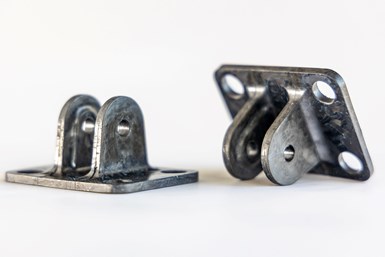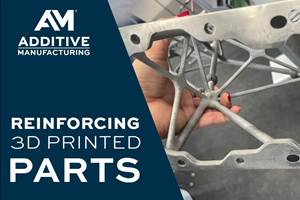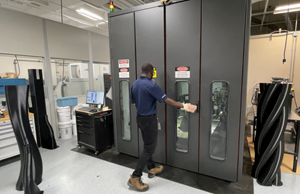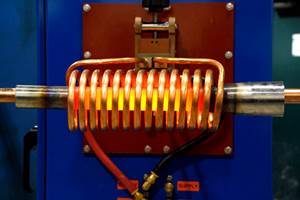9T Labs, Purdue Partner to Advance Composite Use in Structural Aerospace Applications
The collaboration is working to define a new composite manufacturing standard that enables users to produce structural composite parts as easily as metal parts.
Share
9T Labs is collaborating with Purdue University to research and test the potential of manufacturing structural aerospace composite applications at scale with 9T Labs’ additive fusion technology (AFT). This partnership with Purdue, one of the leading engineering universities in the U.S., is a first-of-its-kind U.S. collaboration for 9T Labs, which has expertise in digital, automated and cost-competitive serial production of continuous fiber components.
This hybrid solution combines high-resolution additive manufacturing (AM) with the speed of bulk molding compound (BMC) overmolding to automate manufacturing. It is being developed to offer a cost-competitive option versus the traditional production of aluminum aerospace parts. 9T Labs says its approach to continuous fiber, 3D printed preform parts has already shown great promise in the transportation, medical and robotics industries, among others.
Purdue University’s Composite Manufacturing and Simulation Center (CMSC) in West Lafayette, Indiana, provides the necessary tools and resources to analyze, simulate and test the performance of composites. 9T Labs and Purdue worked collaboratively to develop the application workflow to efficiently engineer and manufacture high-performance parts using BMC chips and continuous-fiber 3D printed preforms. Initial testing shows that customized, continuous-fiber hybrid parts can be digitally designed, 3D printed and co-molded with BMC materials, ensuring performance at only a fraction of the usual cost of continuous fiber materials.
“Traditional composite manufacturing is expensive, wasteful and limited in its geometric freedom, particularly for small-sized applications,” says Yannick Willemin, head of marketing and business development, 9T Labs. “We are defining a new composite manufacturing standard that allows us to produce structural composite parts as easily as metal parts. Our new partnership with Purdue University is a meaningful step toward making this technology more broadly available and accessible within the next 12-18 months.”
The origins of this partnership trace back to when 9T Labs’ CEO and Co-founder, Martin Eichenhofer, learned of John L. Bray distinguished professor of Engineering at Purdue University, Dr. R. Byron Pipes', work on composites during his doctoral studies. “When I heard about the new Composite Manufacturing and Simulation Center led by Dr. Byron Pipes, I reached out to him to discuss what we were doing at 9T Labs,” Eichenhofer says. “His curiosity was piqued and we discovered an opportunity to work together on advanced thermoplastic composites.”
Beyond the practical applications and potential that the AFT hybrid solution brings to multiple important industries, there are strong economic and sustainability benefits to using this technology. “We’ve chosen to collaborate with 9T Labs because we believe that their development of AFT and their novel hybrid approach is the future of the composite manufacturing industry,” Dr. Pipes says.
The combination of zero-waste approach, the possibility to recycle thermoplastics, and the positive impact on part performance being at least 50% lighter than the metal benchmarks makes AFT a very attractive standard of manufacturing.
“This technology we are developing with 9T labs for molding BMC material systems with a relatively small fraction of continuous-fiber printed preforms offers significant potential to enhance the strength performance of molded components without compromising manufacturing rates,” says Dr. Eduardo Barocio, assistant director for additive manufacturing at Purdue.
9T Labs is at the forefront of a completely new field of composite manufacturing that has real- world implications for structural and processing simulation, material compositions and characterization, experimental testing, and application engineering. “This new partnership with Purdue is an additional step toward building a consortium of partners from academia and industry to penetrate the market and accelerate the adoption of AFT and composite materials for a broad application field,” Eichenhofer says.
- Read about how 9T Labs’ deposition process places continuous carbon fiber only where necessary to save material, reduce waste, and more precisely control the structure of preform composites.
- In this episode of The Cool Parts Show, AM editors explore a new way of manufacturing a bracket for a helicopter door hinge, and similar small parts today made from metal.
Related Content
Video: Reinforcing (and Joining) Parts After 3D Printing
Reinforce 3D has developed a method that can be applied to strengthen 3D printed parts by feeding continuous fiber and resin through them. The technique also enables joining parts of various materials and manufacturing methods.
Read MoreEaton Developing Carbon-Reinforced PEKK to Replace Aluminum in Aircraft Air Ducts
3D printable material will meet ESD, flammability and other requirements to allow for flexible manufacturing of ducts, without tooling needed today.
Read More3D Printing Supports Induction Coils — and Emergency Needs
As a participant in Michigan’s Project DIAMOnD initiative, Tucker Induction Systems received a 3D printer to use any way it saw fit, provided the capacity remains available in case of emergency. Use cases and lessons learned as part of this distributed manufacturing network.
Read More3D Printed Spares, Electrification and Cool Parts: Top 10 Stories of 2022: AM Radio #31
Our top articles and videos from 2022 reflect increasing use of additive manufacturing for replacement parts; growing applications for electric motors; and a maturing user base. Read through the top 10 list or listen to the AM Radio podcast episode all about these stories.
Read MoreRead Next
3D Printing Brings Sustainability, Accessibility to Glass Manufacturing
Australian startup Maple Glass Printing has developed a process for extruding glass into artwork, lab implements and architectural elements. Along the way, the company has also found more efficient ways of recycling this material.
Read MoreAt General Atomics, Do Unmanned Aerial Systems Reveal the Future of Aircraft Manufacturing?
The maker of the Predator and SkyGuardian remote aircraft can implement additive manufacturing more rapidly and widely than the makers of other types of planes. The role of 3D printing in current and future UAS components hints at how far AM can go to save cost and time in aircraft production and design.
Read More4 Ways the Education and Training Challenge Is Different for Additive Manufacturing
The advance of additive manufacturing means we need more professionals educated in AM technology.
Read More








.png;maxWidth=300;quality=90)















